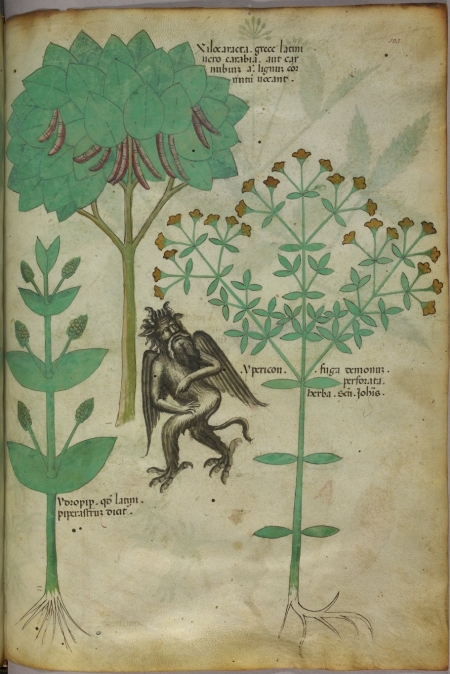A friend recently passed along a fabulous blog called BibliOdyssey, as well as a post with illustrated manuscript belonging to a 15th c. herbal text titled the Codex Sloane 4016. Like other early manuscripts focusing on herbs, these treatises documented accumulated knowledge about medicinal plants from the oral tradition. In the image above you will immediately recognize St. John’s Wort as the medieval “ypericon”, known now by the latin hypericum perforatum. With the myriad uses for the invaluable St. John’s Wort, SSRI action, anti-viral activity, and vulnerary for nervous system-related symptoms among them, what I did not know was that St John’s Wort was also considered a demon repellent. And what a cute little demon we have here in this medieval illustration, not unlike the many forms of hybrid creatures found on the column lintels that would have surrounded monastic herb gardens of that period. I am sure every monastery had its St. John’s Wort patch for this reason, among the many other uses. Do pop back to this post to see the other lovely illustrated manuscripts from the Codex, as well as information about its facsimile at the British Library and even more delightful tidbits from their blog. And while you are at it, this wonderful collection of downloadable manuscripts, the Codex (Tractatus de Herbis) among them. Ahhh, if I were to go back to working towards a PhD again….I’d be sorely tempted.
Lilith’s Apothecary Herbal Body Care
a blog about a natural, herbal body care business including recipes, inspiration, and experiences
Follow my Blog!
-
Join 528 other subscribers
Categories
-
Recent Posts
- alcohol anti-inflammatory artisan baby balm bath body business care chamomile children cold colds craft culinary discount DIY eco essential etsy extract facial featured flu fruit gift green handmade healing herb herbal herbs holiday home homemade honey infused infusion ingredients inspiration local making medicinal medicine natural oil organic personal philadelphia philly product products recipe recipes remedies remedy research ritual sale serum shop show skin skincare spring store support sustainable tea therapeutic therapy tincture tisane treatment winter
Lilith’s Apothecary on Etsy
Join me on Twitter!
Tweets by herbmuseArchives
- February 2012
- January 2012
- July 2011
- May 2011
- April 2011
- March 2011
- February 2011
- December 2010
- November 2010
- October 2010
- September 2010
- August 2010
- July 2010
- May 2010
- April 2010
- March 2010
- February 2010
- January 2010
- December 2009
- November 2009
- October 2009
- September 2009
- August 2009
- July 2009
- June 2009
- May 2009
- April 2009
- March 2009
- February 2009
- January 2009
- December 2008
- November 2008
- October 2008
Get Email Notification

I wish the picture were clearer; then I could translate the Latin in it. The only word I can really pick out is “fuga”, which = “flight” or “escape”.
🙂
Thank you for your thoughts on this 🙂